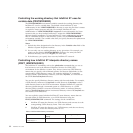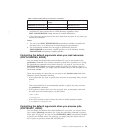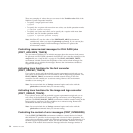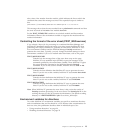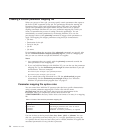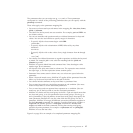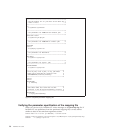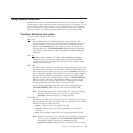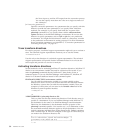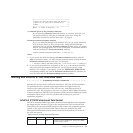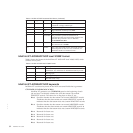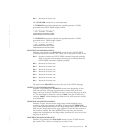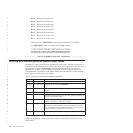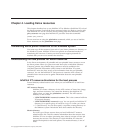the Xerox input to, and the AFP output from the conversion process.
You can also specify more than one value on a single occurrence of
the -t directive.
[-x
"conversion_parameters"]
Specifies conversion parameters. Any parameters that you specify with this
directive override the same parameters if you specify them with other
methods. For example, if you specify them with the -x option of the
pdxtx2afp command or if you specify them with the other-transform-
options
attribute in the InfoPrint Manager environment. Do not use this
directive to specify parameters such as xjdl or xjde for your production
environment. You might find this directive useful as a temporary override
to the production environment for testing purposes. For more information
about conversion parameters, see Appendix A, “Conversion parameters for
converting Xerox jobs,” on page 93.
Trace transform directives
For service purposes, a technical support representative might ask you to activate a
trace. The technical support representative instructs you to use this format:
-x xztrace=all1:all2
Use this only at the direction of a technical support representative. The technical
support representative will provide further information about how to locate the
trace output and provide it to service for analysis.
Activating transform directives
Several methods exist for activating InfoPrint XT transform directives. InfoPrint XT
checks for an environment variable first and for a directives file second. If you
enter the pdxtx2afp command directly, InfoPrint XT then checks for the -t
command option. If you use InfoPrint Manager with InfoPrint XT, InfoPrint XT
checks for a document attribute instead of the command option.
PDXTX2AFP_DIRECTIVES environment variable
You can add the environment variable as a system variable so that
directives are active for any user account that runs the transform. Restart
the Windows system after you add the environment variable. These are
examples of values that you can enter in the Variable value field of the
Windows System Properties interface:
-t x2afp.out -k1
-a1
%PDXTWORKDIR%\pdxtx2afp.directives file
This is a plain text file that contains the directives. Each directive entry is
specific to a destination. If you use InfoPrint Manager with InfoPrint XT,
the destination is the name of an InfoPrint Manager actual destination.
Otherwise, the destination is the destination that the -p option of the
pdxtx2afp command specifies. You can also use *: as a destination so that
the associated transform directive applies to all job destinations. You can
include comments and blank lines in the directives file. Delimit comments
with a number sign, #. These are examples of the types of entries that you
can make in the transform directives file:
#-------------------------------------------------------#
# For all destinations, capture the InfoPrint Manager #
# attributes in the jobattr.ipm file. #
#-------------------------------------------------------#
*: -a1
30 InfoPrint XT Guide



